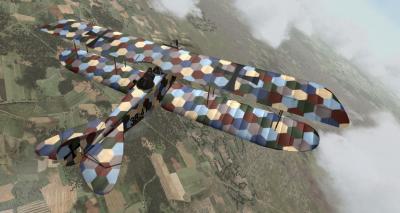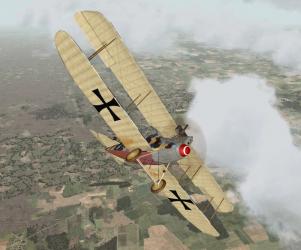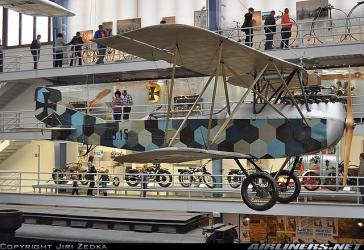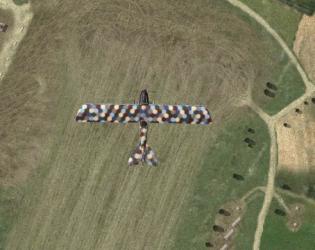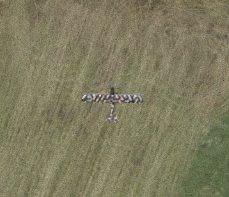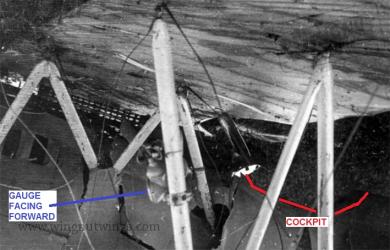

Bullethead
JAGDSTAFFEL 11-
Posts
2,578 -
Joined
-
Last visited
-
Days Won
2
Content Type
Profiles
Forums
Gallery
Downloads
Store
Everything posted by Bullethead
-
View File BH_DFW_CV_KuK_Random_Hex.zip Yet another skin for the DFW C.V in OFF. This one is done in Austro-Hungarian hex camo. The fuselage is 7 colors, totally random. The upper surfaces are 6 colors arranged semi-randomly in stripes and squiggles. I got this paintjob from (many) photos of Knoller C.II(Lo) number 119.15 in a museum in the Czech Republic. The paintjob is copied hex-for-hex from that plane, but because the DFW is somewhat larger and has different proportions, the pattern doesn't quite fit and I had to ad lib all the wingtips. NOTES: The hex pattern is NOT supposed to like up between the top and the sides of the fuselage--they don't on the real plane. Also, there are some texture mapping issues, most noticeably on the upper wing just left of center at the trailing edge. Pretend those are repair patches--nothing I can do about them. Submitter Bullethead Submitted 08/26/2012 Category Aircraft Skins
-
Well, by working on this skin all day until now, I managed to get it finished today, and uploaded to the database here. And there was great rejoicing Here's the link: http://combatace.com/files/file/13265-bh-dfw-cv-kuk-random-hexzip/ This is BY FAR the most tediously difficult skin I've ever made and it'll be a cold day in Hell before I do another plane with this type of paintjob . To make matters worse, this was my 1st project to use PSP X4 on, and there are a LOT of changes to get used to from my old PSP 7.... But I think I got the hang of it. 7 colors on the fuselage sides, 6 on the upper surfaces. A couple of notes: 1. I modeled the paintjob off photos of the real plane, 2 of which I've attached below. As you can see, the hexes on the real plane don't like up between the fuselage sides and top, so I felt no obligation at all to struggle with that issue :). 2. There are OFF mapping problem near the center of the top wing's trailing edge. Nothing I can do about them, so pretend those are repair patches. 3. Try not to scratch the paint
-
Version 1.0
28 downloads
Yet another skin for the DFW C.V in OFF. This one is done in Austro-Hungarian hex camo. The fuselage is 7 colors, totally random. The upper surfaces are 6 colors arranged semi-randomly in stripes and squiggles. I got this paintjob from (many) photos of Knoller C.II(Lo) number 119.15 in a museum in the Czech Republic. The paintjob is copied hex-for-hex from that plane, but because the DFW is somewhat larger and has different proportions, the pattern doesn't quite fit and I had to ad lib all the wingtips. NOTES: The hex pattern is NOT supposed to like up between the top and the sides of the fuselage--they don't on the real plane. Also, there are some texture mapping issues, most noticeably on the upper wing just left of center at the trailing edge. Pretend those are repair patches--nothing I can do about them. -

WOFF term "two weeks" at last understood!
Bullethead replied to RAF_Louvert's topic in WOFF UE/PE - General Discussion
Ah, I was wondering why this place was so dead, but I put it down to waiting for WOFF and not hearing much about it. -

Austrian Semi-Random Hex Camo (Work in Progress)
Bullethead replied to Bullethead's topic in WOFF UE/PE - General Discussion
Thanks for the feedback, guys. @ Hasse Wind I tried to see what it looked like against a snow background but I suppose my QC pilot I use for testing is in a unit stationed too far south because the ground was still green in winter. @ Olham The pics on that page illustrate the problem with Austrian camo colors. The wilder ones (that are mostly red, orange, and yellow) use colors now known to have been derived from fraudulent artifacts. And notice that they don't agree on the color of Linke-Crawford's personal markings (the wide band with the L on it). The 12th pic down (a painting with a couple of Italian planes in the background) is actually the same Berg (Linke-Crawford's) based on a reappraisal of the colors, and is just 1 of many. The 5th pic down is a different Berg but also uses an interpretation of the "new" colors. In other notes, the 3rd pic from the bottom (photo of guy standing beside plane) isn't an Aviatik D.I. It's actually the Aviatik 30.14 prototype, the earliest ancestor of the D.I. Note that on this plane, the upper wing is well above the fuselage and the forward fuselage is low, giving the pilot a good view ahead. This was totally contrary to Austrian design policy so in the final D.I, the forward fuselage was built up higher to totally block the pilot's view (see the cockpit photo) and the upper wing was set down right on top of it, just to make sure. In the cockpit photo, the pilot's eye level was about where that tube with all the valves on it is, just above the steering wheel (another interesting feature). But most of the planes shown on this page are later models with the guns raised up to the top of the cockpit. This required cutting away the forward fuselage and the trailing edge of the upper wing, but only right there so the gun breeches could be opened. Further forward, the fuselage still was above the pilot's eye level, so these modifications didn't improve visibility very much. Also, even though the high part of the fuselage was pretty narrow, the radiator at the front was much wider, just to make sure the pilot couldn't lean over and see ahead. Finally, look closely at the exposed wing structure in the last pic. See how the tops and bottoms of the ribs come together well forward of the trailing edge, leaving single sticks from there back? That was how Professor Knoller designed wings and Berg copied the idea for his fighter. The wing trailing edge was intended to flex so the camber would flatten out as speed increased, thereby reducing drag. Needless to say, this made a very weak structure that often failed, both on Knoller's own planes and the D.I. @ Panama Red Once I get done with this, it'll be a LONG time before I touch another Austrian hex camo scheme. I've made hex camo before but they've all had repeating patterns. Thus, I could make a small part and paste copies, all quick and easy. This scheme, however, has no repetitiion at all, so I have to assemble it 1 hex at a time. Very, very laborious and tedious. @ Jarhead and Hauksbeb Sometimes camo wasn't designed to hide the object but just make it hard to aim at. For instance, all those weird and highly obvious black and white (plus some other colors) dazzle or "disruptive" camo schemes painted on ships in WW1 and WW2. In those days, shooting guns and torpedoes accurately required fairly good estimates of the target's range, course, and speed, most of which were obtained by eyeball observation. So the idea of these schemes was to make it hard to tell which way the ship was going (and thus how fast, and thus how far away). The Brits also painted some of their ships pink like those landrovers. They called it "Mountbatten Pink". It was great for blending into the horizon at dusk and dawn but was highly obvious when the sun was up, so eventually it gave way to "Admiralty Disruptive". In Desert Storm, the Brits discovered that if they hung floodlights on vehicles, they blended into the heat mirage of the desert. However, by the time I got there, it was winter so there wasn't any heat mirage and pretty soon the oil wells started burning so you couldn't see more than a couple hundred yards anyway. Thus, my unit never tried that. -

Matt's first Jousting Lesson
Bullethead replied to UK_Widowmaker's topic in WOFF UE/PE - General Discussion
Widow, that's amazing. Damn if I'd let anybody I care about (and whose medical bills I pay) do jousting. I've seen it done and there are almost always all sorts of broken bones, concussions, dislocations, internal injuries, etc. Fingers crossed your boy survives with only cuts and bruises -

WOFF term "two weeks" at last understood!
Bullethead replied to RAF_Louvert's topic in WOFF UE/PE - General Discussion
Links, man, give us links! I thought this was the official forum and all . And I couldn't even find a screenshot section on the OBD page any more. -
While trying to learn more about Austrian camo, I came across a photo of a real Austrian plane in a museum in the Czech Republic. So, I decided to try to find out more about it, in the process finding a bunch of other photos from differen angles, allowing me to see what the camo looked like on just about every surface. And I discovered something very interesting. While the fuselage has a totally random arrangement, the wings have more of a pattern than not, which I call "semi-random". These hexes make lines and loops alternating dark and light. Thus, I became curious as to how this camo scheme would have looked in the air and started skinning it. I also looked up the plane. Apparently it was restored about the time more info about Austrian colors was coming along, and they seem to have had the remains of the original paintjob to go from. The colors were, in fact, pretty close to the ones I'd been using, so I was happy there. So I tweaked my colors to match this plane's, which involved making the darks darker and the lights lighter, which created more contrast to make the semi-patterns show up better. The plane in question is a Knoller C.II(Lo), number 119.15. Thankfully (because these planes were total crap), we don't have one in OFF, so I applied the scheme to our beloved DFW, for which I already have a template. The DFW is a bigger plane with different proportions and shapes here and there, but the scheme fit on it fairly well. I copied it from the real plane hex-to-hex, except for a few areas where the DFW's bigger structure stuck out beyond the pattern, or where I lacked a photo. Then I looked at it in the game. Because I spent almost all day and now about 1/2 the night laboriously copying and pasting individual hexes together, I wanted to show it off. As you can see, this is still very much a work in progress. For instance, I still have to hex the lower wing. I'm sure that once I'm done, I will never want to play another board wargame again :). Anyway, it's quite interesting. Up close, it just looks weird. At medium distances, you can really see the stripes and squiggly lines on the upper surfaces. And at long distances, the plane's outline is pretty well broken up. The camo thus seems strangely effective. Oh well, I suppose I'll finish this in a few days and post some better pics.
-
There have been many attempts to make things you could convert from car to plane, going back at least as far as Glenn Curtiss himself in 1917. There's even a guy reviving the concept today. Sadly, most of these things ended up in the book, The World's Worst Aircraft, by Bill Yenne. And it wasn't just crackpot inventors tinkering with them, either. The (at the time) major firm of Convair even made one (Model 118), which made the front of the book's dust jacket. As I understand things, the flying cars weren't aerodynamic failures, they were victims of misjudging the market. Most of them came out right after WW2 in expectation of thousands of wartime-only pilots still wanting to fly in civilian life. It seems that few did, however, for the same reason it took me 20 years to go camping again after my war. And for those who DID want to keep flying, the market was utterly saturated with better military surplus planes available dirt cheap. So there weren't nearly as many potential customers as expected and those customers could buy a better car and a better plane for the price of one of these flying cars. Even if there's more of a market these days (assuming the economy gets better), I still wonder how such vehicles would survive in the modern regulatory environment. I mean besides having no doubt to insure and register the thing as both a car and plane, the vehicle would have to meet all the crash test, fuel economy, and emissions standards of cars, plus whatever similar requirements planes have today. And then there's the question of maintenance. I suppose hours spent in car mode would count towards airframe hours so the flying time between periodic inspections and overhauls would be less. And what if you got into a wreck as a car? I'd expect the FAA would want to know and get involved, and you'd probably have to have a certified aviation mechanic do any repairs.
-

WOFF term "two weeks" at last understood!
Bullethead replied to RAF_Louvert's topic in WOFF UE/PE - General Discussion
I looked all through the sticky screenshot thread just a couple days ago. I haven't watched the movies lately, but I do recally on seeing Handley Page bombers, not Gothas. But anyway, there are definitely no French 2-seaters in evidence yet. -

Anemometers and Airspeed Indicators
Bullethead replied to Pips's topic in WOFF UE/PE - General Discussion
Greenhouse gases -
Provided the boots have artillery ;).
-

WOFF term "two weeks" at last understood!
Bullethead replied to RAF_Louvert's topic in WOFF UE/PE - General Discussion
Well, still not pics of the Gothas (and maybe Giants) that must exist given the attention to London's details, the searchlights, and the barrage balloons. No pics of Camel nightfighters with twin Lewis guns on the upper wing. And most disappointing of all, no pics of French 2-seaters of any kind, the absence of which would still leave the French and US sectors of the line not worth playing. -
@Elephant Brilliant pic that shows all the important parts (although I'm wondering if it was reversed, given this would be on the right wing instead of the left). That instrument's housing looks the same as that on Olham's Pfalz and the lack of rigidity is obvious, explaining how the Pfalz's got bent to face forward. Furthermore, those look like metal, not wooden, struts, and the mounting brackets wrap around as clamps, so no screw holes.
-
But artillery is the God of War . As to grunts complaining about tanks, I do know of one instance, from a Bill Maldin "Willy and Joe" cartoon:
-
LOL! What with the Pfalz being surplus to German needs, I imagine they experimented with them. Apparently this one was involved in comparative trials of the German version and the TT2.
-
Yes, exactly. That's what I've been trying to say. The AWM couldn't find any screw holes in the strut, but that doesn't mean there wasn't an anemometer (or even a Teddybär) there if it was mounted with one of those clamps (or strips of fabric).
-
That's an interesting pic, Olham, but I'm not sure it answers the question, for 2 reasons: 1. The anemometer was dislodged in the crash and is not in its original position. This is shown by the fact that the gauge is now facing forward and down, so would be unreadable from the cockpit. 2. It's hard to tell for sure because it's out of focus, but the clamp on the strut in the foreground appears to wrap around the strut intead of being screwed onto it. Thus, there wouldn't be screw holes in the strut. I also note that the anemometer is a different model from the one shown in the close-up color pic. The shape of the housing is quite different, so there's no guarantee it had a thick, cast-on mounting flange like that. Such a flange would not bend, but something obviously bent to get the anemometer into its current position without it breaking off the plane entirely. It's a shame the strut in the foreground hides the rear of the housing and its attachment points.
-
Well, the anemometer couldn't have been mounted directly to the strut because then the gauge would have faced either straight forward or backwards instead of at the cockpit. Thus, some sort of braket had to be used. If it was a clamp around the strut as in your lower picture, then it wouldn't have left screw holes, either.
-
That's cool, but where'd they find a stretch of desert with out dust? I'd imagine this thing would kick up a huge plume of whatever was on the ground (dust, leaves, gravel) in most places. And I'd hate to lose my balance and fall into the fans :). Still, I WANT ONE! I'm already thinking of the cool skateboard-type tricks I could do with it
-
You're not kidding about how dangerous tanks are. I recall folks saying how the Iraqi army wasn't much of a threat because most of their tanks were T-55s. But I found out that if it's just you in a hole with your 5.56mm weapon, a T-55 coming at you might as well be a tornado, a pyroclastic flow, or some other utterly unstoppable, casually anihilating force of nature. Fortunately, it didn't see me and went away . On the size of WW1 tanks, except for the little Renault (about the size of a VW Beetle), they were friggin' huge by today's standards in all dimensions. While their bodies were the same width as today's tanks for the same reason (to fit on trains), the British tanks had those gun sponsons that stuck out much further. These were actually retractable for transport and they used 1 tank to push or pull the sponsons in and out on another tank. This required the tanks to be very tall, to have room inside for the retracted sponsons. And they were built very long to be able to cross wide trenches. In fact, they got longer as the war progressed and the Germans began digging bigger and bigger anti-tank ditches. For example, the Mk V tank (mainstay of the Brit army in 1918) was 26.5' long, while the Mk VIII (its intended replacement, scheduled for mass production in 1919) was over 34' long. I used to have a photo of me standing beside the Jagdtiger at Bovington Camp. I'm 5' 11" and the top deck of the hull was a bit above my eye level.
-

Screen Shots, Videos, Media, OFF Posters
Bullethead replied to MK2's topic in WOFF UE/PE - General Discussion
Very nice tweaking of pictures, CS! I'll have to look at this Piscasa thing of which you speak. -

WOFF term "two weeks" at last understood!
Bullethead replied to RAF_Louvert's topic in WOFF UE/PE - General Discussion
Gunrunner, I 1st encounted the term "2 weeks" on discussion boards dealing with the ancient DOS version of Kesmai's Air Warrior MMOFS. That was back in the early 1990's.... But regardless of how "2 weeks" is measured, I think it safe to say that it's beem more than "2 weeks" since we got a new batch of WOFF screenshots. Last night I went back through the sticky thread above, marveling at all the cool stuff, and noticed that the last shots are from November 2011. IOW, we haven't gotten any all year. -
If you want to see old tanks, you definitely must visit the Tank Museum at Bovington Camp in southern England. This museum has at least 1 specimen of practically every type of tank ever built, including the very 1st tank ever, "Little Willy". I've been there twice and found it quite difficult to leave. Anyway, the WW1 wing of the museum has an extensive colletion, including a tank that participated in the 1st tank attack on the Somme in 1916 (and has the scars to prove it). Most of the vehicles at the museum are in working condition and they have "ground shows" where they drive them around the yard for spectators. http://www.tankmuseum.org/
-
Don't blame me for pulling this thread off course. Not once have I mentioned absinthe. I agree that all this absinthe talk has prevented discussion of the very important point I was trying to make in my post. Aparently nobody looked closely at the TT2 in my picture. If they had, they'd have seen that it was attached to the strut with what appear to be spare rib tapes from squadron stores. This is important in reference to the OP's quote from the AWM, who said an exhaustive search for screw holes came up empty on the struts. All these strut-mounted anemometers, whether the German "propeller beanie" type or the Austrian Teddybär, were self-contained devices. They were powered by the passing wind and incorporated their own display for their data, so they needed no wiring. It was simply a matter of attaching them to the airplane somehow; thus, they could easily be swapped between aircraft. At least in the Austrian case, the primary means of attachment seems to have to lash them to the strut with fabric strips, leaving no screw holes. Thus, on surviving examples of KuK planes, an absence of screw holes does not imply that the plane never had a TT2 installed. So, I was trying to suggest that the Germans might also have used fabric lashings instead of screws and brackets.

